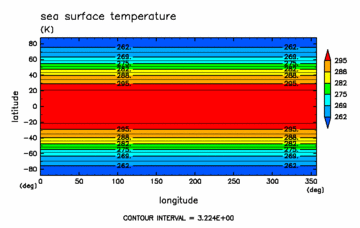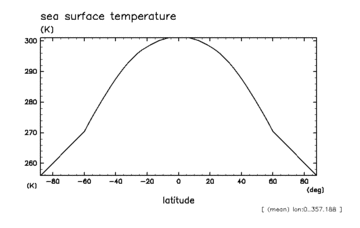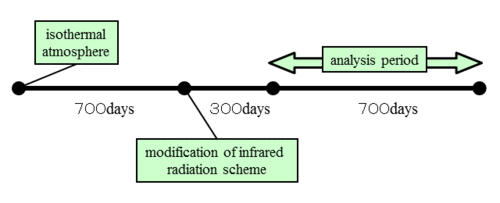
|
| 2. Model and Setup | [prev] [index] [next] |
The model used in this study is AGCM5 of the GFD-Dennou Club (SWAMP Project, 1998; Hayashi et al., 2000). This is a simple atmospheric general circulation model (GCM) based on the three dimensional primitive equation on a sphere, which contains a water transport and some simplified physical processes.
The model employs following schemes for physical processes.
We remark that the Kuo scheme is the same as the cumulus parameterization used in HS86 and is expected to be preferable for the development of wave-CISK like structure.
The equation of motion, the continuity equation, the thermodynamic equation, and the water transport equation are discretized by the use of the pseudo spectral method in the horizontal directions and by the finite difference method in the vertical direction. The spatial resolution is T42 horizontally (i.e., base spherical harmonics utilized is all of those with total wavenumber from 1 to 42) and is sixteen levels vertically.
For each cumulus parameterization, five cases of experiments are performed, varying the band absorption coefficient in the infrared radiation calculation around the value employed in Hayashi et al. (2000) (Fig.1.1). By the variation of absorption coefficient resulting in the change of the vertical profile of radiative cooling, we expect that the vertical profile of condensation heating would be varied indirectly. This is because, in a gross sense, the condensation heating of the cloud is expected to balance the radiative cooling in the atmosphere as a whole (i.e. the radiative-convective equilibrium; Manabe and Stricker, 1964 ). In fact, as will be shown later, vertical profiles of condensation heating varies in accordance with the set of values adopted for infrared absorption coefficients ( Fig.3.1 in subsection 3.1 for the cases with Kuo scheme; Fig.4.1 in subsection 4.1 for the cases with moist convective adjustment scheme ). In the followings, as will be defined in subsection 3.1 and subsection 4.1, we will name the cases in which the condensation heating takes maximum in the lower troposphere (experiments kuo-a and adj-a) as lower-level cooling experiments, whereas the cases in which the condensation heating takes maximum in the upper troposphere (experiments kuo-c and adj-c) as upper-level cooling experiments, and will compare them in detail.

|
All of the ground surface is assumed to be the ocean whose temperature is constant in time (aqua-planet condition). The horizontal distribution of the sea surface temperature is the same as that used in Hayashi et al. (2000) ; it is zonally uniform and north-south symmetric, taking the constant value of 302[K] equatorward of 7 degree latitude (Fig.1.2).

|

|
| Fig.1.2: The horizontal distribution of sea surface temperature (the unit is [K])(left) and its latitudinal profile(right). | |
|
Each experiment is initialized by the condition of the model at day 700 of the model run with the parameter of kuo-con or adj-con starting from an isothermal atmosphere. After the modification of infrared radiation scheme, we spin-up the model for 300 days, and analyze the data during the following 700 days (Fig.1.3). |

|
| [prev] [index] [next] |